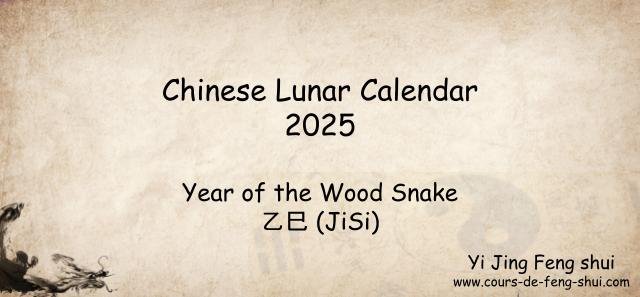
Lunar Months, Full Moons, and New Moons in 2025 – Year of the Wood Snake 乙巳 (JiSi)
The Chinese lunar calendar is based on the moon’s cycles, with a lunar cycle starting at the new moon. The first day of each lunar month begins with the new moon, and the fifteenth day corresponds to the full moon. The Chinese calendar integrates both lunar and solar systems. While the lunar calendar is based on the phases of the moon, the solar calendar divides the year into 24 solar terms or seasons, corresponding to the sun’s position in the tropical zodiac, similar to Western astrology.
New Moons and Full Moons
- The new moon marks the beginning of a lunar cycle, when the moon is positioned between the Earth and the Sun. The moon is said to be waxing from new moon to full moon, with its illuminated surface increasing daily.
- The full moon occurs when the moon is on one side of the Earth, and the Sun is on the opposite side. The moon is said to be waning from the full moon to the next new moon, as its illuminated surface decreases daily.
The Influence of the Moon
The first half of the lunar month represents the growth of Yang energy and the decline of Yin energy, reaching its peak at the full moon. The second half of the lunar month symbolizes the growth of Yin energy and the decline of Yang energy, with the new moon representing the peak of Yin energy.
The Moon Festival
The Moon Festival, also known as the Mid-Autumn Festival, takes place on the fifteenth day of the eighth lunar month. During this time, the full moon is at its roundest and brightest of the year. In Chinese culture, this festival symbolizes family unity and togetherness.
Calculating the Date of Chinese New Year
Chinese New Year generally occurs on the second new moon after the winter solstice. In 2025, the first day of the Chinese New Year falls on January 29th. However, for astrological, divination, and Feng Shui purposes, the new year begins with the solar term LiChun, which starts on February 3rd.
Lunar Months and New Moon Dates in 2025
- First Lunar Month begins on January 29
- Second Lunar Month begins on February 28
- Third Lunar Month begins on March 29
- Fourth Lunar Month begins on April 28
- Fifth Lunar Month begins on May 27
- Sixth Lunar Month begins on June 25
- Sixth Lunar Month (Leap) begins on July 25
- Seventh Lunar Month begins on August 23
- Eighth Lunar Month begins on September 22
- Ninth Lunar Month begins on October 21
- Tenth Lunar Month begins on November 20
- Eleventh Lunar Month begins on December 20
- Twelfth Lunar Month begins on January 19, 2026
- First Lunar Month of 2026 begins on February 17, 2026
Full Moon Dates in 2025
The full moon occurs on the 15th day of each lunar month in the Chinese lunar calendar. During a full moon, the Earth, Moon, and Sun are nearly aligned, allowing the moon to be fully illuminated.
- January 14: Full Moon of the 12th Lunar Month
- February 12: Full Moon of the 1st Lunar Month
- March 14: Full Moon of the 2nd Lunar Month
- April 12: Full Moon of the 3rd Lunar Month
- May 12: Full Moon of the 4th Lunar Month
- June 10: Full Moon of the 5th Lunar Month
- July 9: Full Moon of the 6th Lunar Month
- August 8: Full Moon of the 6th Lunar Month (Leap)
- September 6: Full Moon of the 7th Lunar Month
- October 6: Full Moon of the 8th Lunar Month
- November 4: Full Moon of the 9th Lunar Month
- December 4: Full Moon of the 10th Lunar Month
- January 3, 2026: Full Moon of the 11th Lunar Month
- February 2, 2026: Full Moon of the 12th Lunar Month